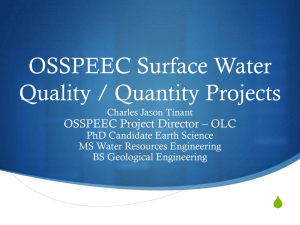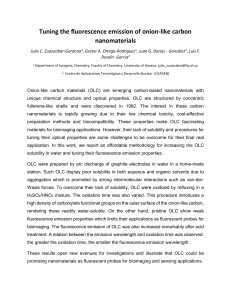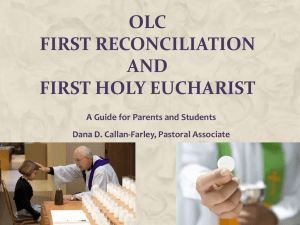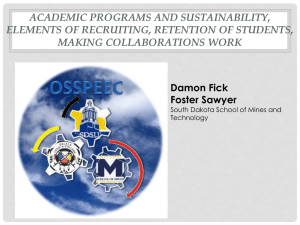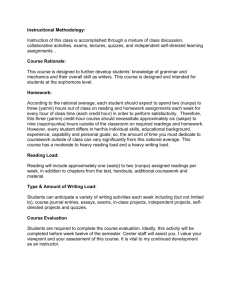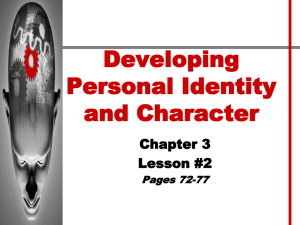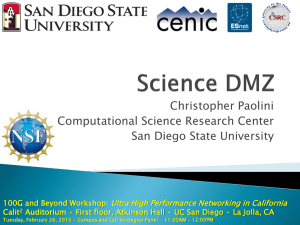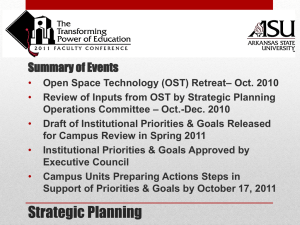4) Service Learning
advertisement
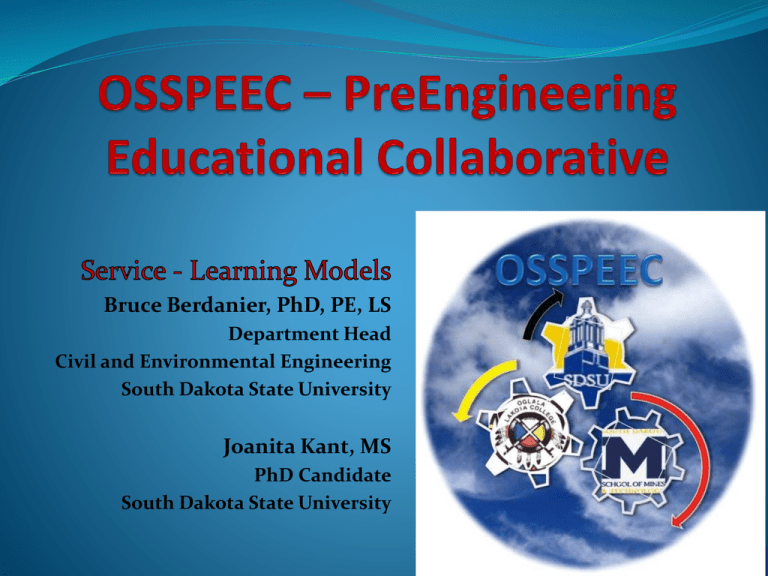
Bruce Berdanier, PhD, PE, LS Department Head Civil and Environmental Engineering South Dakota State University Joanita Kant, MS PhD Candidate South Dakota State University Constructivism and Service - Learning Constructivist Pedagogy: ● Emphasizes knowledge gained through guided experience where the learner builds complex and interrelated understandings. ● Deep knowledge develops where information is a “light on in the mind” not a “load on the mind.” ● The Kolb-Fry experiential learning model is a spiral usually beginning at step one but can begin at any of the four steps in a repetitious cycle. Why? What if? What? How? 1. concrete experience 4. testing abstract concepts Kolb and Fry Experiential Learning Model 3. formation of abstract concepts based on reflection 2. observation and reflection on the experience OSSPEEC’s modified learning strategy emphasizes: • guided experience • guided reflection • cross-disciplinary learning • a “systems” approach to understanding the environment • unintended consequences of human interventions. Definitions PowerPoint revised after Diane Nagy 2011 Academic service-learning is a strategy that integrates service in the community with academic study to meet specific learning goals for students. Faculty, in partnership with community agencies, design service projects that will Meet community-identified needs Advance students’ understanding of specific course content Promote civic engagement Critical reflective components are built into the course to help students consider relationships between their service, the course curriculum, current societal issues, and their professional goals. Experiential service-learning is different, only in that it does not involve a course for credit. OSSPEEC provides examples of both. An Introduction Summer 2012 ServiceLearning Initiative OSSPEEC involves internships and field education service-learning Service-Learning Academic insight Values and expertise Community Defined Off-campus populations underserved by our market economy Organizations whose primary purpose is the common good Agencies whose mission provides stewardship: public works, natural resources OSSPEEC and CU students collaborating on net-zero home for the Pine Ridge community Essential Elements Emphasis on reciprocity Learning and service objectives are clearly identified and congruous Service is meaningful, challenging, and meets a real need Reflection is continuous, structured, and complex Fosters learning about larger social issues Service Projects One-time group projects Cross-disciplinary projects Multi-semester projects Alternative Weekend Opportunities Alternative Breaks (immersion experiences) OSSPEEC students and faculty Lester Richards, Tyler Corbine, Shane Herrod and Dr. Damon Fick (SDSMT) at Wanblee Veterans Wall Principles of Good Practice If academic credit is awarded, it is for learning, not for the service Includes set learning goals for students Criteria for the selection of service sites Kyle White presenting on summer 2011 surveying work at Piya Wiconi OSSPEEC / SDSMT field camp fieldtrip to drill a temporary monitoring well on Rapid Creek Critical Reflection Links experience to course, or prior course, learning objectives Is guided and purposeful Tinant, Means and Hansen measuring Challenges assumptions and complacency deflection Occurs before, during, and after service Includes components that can be evaluated according to well-defined criteria Involves reading, writing, doing and telling Clarifies values and fosters civic responsibility Invites feedback Benefits to Agencies • Infusion of people power to meet needs • More informed/involved citizenry • Increased name recognition • New ideas and energy • Technical assistance • Diversity enhancement • Access to university resources • Reinvigorate staff OLC students Jake Fergusson, Aaron Rasor and Delaine Peterson collecting PHAB data to be shared with OST Environmental Protection Agency Benefits to Universities and Colleges Enhance student satisfaction, retention, and graduation rates Improve relationships with community Advance institutional goals: Service, Social Responsibility, Scholarship of Teaching and Learning, Diversity Enhancement Promote coherent collaborative curriculum OSSPEEC student and community member Oliver Covey relating academics and service under a cottonwood tree Benefits to Faculty Enrich and enliven teaching Identify new areas for research and publication Ale Higa (OLC faculty) Develop projects that are simultaneously and next generation at an productive in research, service, and teaching OLC research meeting More efficient use of available resources Foster cross-disciplinary learning communities Benefits to Students Personal – enhanced sense of efficacy, identity, morality Social – diversity, social responsibility, citizenship skills, commitment to service Academic – increased complexity of understanding, problem analysis, critical thinking, GPA, cognitive development, ability to apply learning to “real world” OLC Student Delaine Peterson “enjoying the opportunity to research streams” Heavy Metals Areas of Focus on the PRIR and White River Watershed Traditionally Edible Plants Soils Surface Water Sediment Undergraduate and graduate student research Interfacial Research Engineering, Environmental Science, Biology Heavy Metals Research We work in the “Field” and in the “Lab.” Field and Lab “Rough” and “Sophisticated” White River Project Area 2012 Our Theory Immediate participation of undergraduate students early in their plan of study in field and laboratory experiences initiates their precognition to the benefit of future classroom pursuits confirms their interest in science and technology helps them self identify as a member of another defined community gives them purpose in pursuing an academic degree and career fulfills their need to serve the community through their intellect and efforts Our Experience Students have completed two summers of STEM, service – learning, sampling and analysis Presentations at OLC poster sessions last year and this year Abstracts submitted to AIGEP conference for this fall Next Steps Presentation of this year’s undergrad results at selected conferences Completion of MS this year on White River sediment and water Defined research (sampling and analysis) program for next year Propagation of field/lab summer program Completion of Interfacial PhD during 2013 Charles Jason Tinant OSSPEEC Project Director – OLC PhD Candidate Earth Science MS Water Resources Engineering BS Geological Engineering Community-Defined Needs in Surface Water Quality & Quantity Many community concerns on the Pine Ridge Reservation are centered around water – Questions of Sustainability Drinking Water Quality Is the water safe to drink? Stream Health How is the environment around me changing? Long-term Availability Mni Wiconi / Treaty Rights regarding the Missouri River Compact White River near Badlands Visitor Center – zero flow condition on July 23, 2012 OSSPEEC Partnerships with Community Agencies around Water OST Environmental Protection Program Non-point Source Monitoring / Analysis (Tinant, Benning – SDSMT, Kenner – SDSMT) Natural Resources Regulatory Agency Well-drilling (Schwalm – OLC) Hydrogeology (Sawyer - SDSMT, Sanovia - OLC) Water budget development (Tinant) OST Rural Water Existing relationship with SDSU in water distribution research (Beck – SDSU Civil Engineering) Thunder Valley Development Agency Floodplain modeling (Tinant) Design of net-zero water / wastewater treatment (Berdanier, Fick, Pyatt – UC Boulder) Dr. Schwalm (OLC), Calvin Cutschall, and James Means drilling core at an abandoned mine in Harding County, Pine Ridge Aquatic Ecology Project (PREP) Engineering Need: Watershed health defined by analysis of chemical, biological, and physical parameters; Concrete Experience: Guided WQ and biotic sampling, laboratory analysis; Observation / Reflection: Analysis of macroinvertebrate data, field data, laboratory data, discussion on the bigger social picture; Abstract Thinking (cross-disciplinary learning): biogeochemical cycling, anthropogenic perturbation, stability; Testing Abstract Concepts: Best Management Practice (BMP) design using a systems approach; Jake Fergusson water quality sampling Delaine Peterson and Jake Fergusson sampling macroinvertebrates Streamflow Event Sampling Engineering Need: Fecal coliform and sediment identified as impairments in Pine Ridge Reservation streams Concrete Experience: Stormwater sampling, stream flow measurement, Observation / Reflection: Capacity building with OST Environmental Protection Program, K-12 Outreach Vertical integration: Collaborative project with an MS candidate, SDSMT Senior, and OLC freshman Abstract Concepts: Best Management Practice (BMP) design; storm flows Shane Herrod teaching OLC Freshman Engineering and high school students how to measure stream flow. Practical Irrigable Land Estimation for Pine Ridge Reservation • Engineering Need: OST should quantify future agricultural water needs as part of treaty negotiations with Federal government; • Concrete Experience: Joni Tobacco was formerly Water Director for OST Natural Resources Regulatory Agency; • Abstract Thinking: Modeled PIA from effective rainfall in ArcGIS July 11, 2012 3:00PM ≈1120F Jim Sanovia and students standing on White Clay Geology projects near Pine Ridge, Student South Dakota Outcomes Geology of the White Clay fault area 1:24k quads Structural geology of the White Clay fault area Stratigraphy of the White Clay fault area quads Baseflow analysis of White River streamflow 1992 - 1997: evidence of structural influence on ground water recharge? All pictures taken mid-July 2012 No stream flow recorded This image about 50 miles downstream from images to the right Evidence of structural influence on ground water recharge Teaching hands on field methods for geologic mapping Dr. Foster Sawyer demonstrates field sampling Dr. Hannan LaGarry explains the fossiliferous Niobrara formation to the Instructors also teach students how to properly take field notes, field drawings, prepare their note books, field bags, equipment etc. Field Work to Computer Work Field geologic mapping brought into ArcInfo and digitized to make the Tribe’s first ever 1:24k geologic maps Intern learning GIS geodatabase management Baseflow analysis of White River streamflow July 23, 2012 11:30AM ~1050F Dr. LaGarry Jim Sanovia Interns Interns geologic mapping Service Learning Opportunities Compile a more accurate geologic map for the Pine Ridge Indian Reservation Provide critical hydrologic information for the surface water and ground water systems on the Reservation Wind Energy 80 ft. 20kW turbine Pressure cells Strain gages Accelerometers Wind speed/direction 33 ft. Skystream turbine Three photovoltaic cells SDSMT’s Renewable Energy Research Facility Meteorological Tower at OLC 50 m. meteorological tower Lowered for meteorological repair Instrumentation 3 anemometers Humidity Temperature Objectives Wind data for OLC, Thunder Valley Community Development Potential wind turbine applications Meteorological tower at OLC Outcomes Poster presentations SDSMT Undergraduate Research Symposium AIHEC SD Academy of Science Undergraduate Research credits Spring, 2012 – Shane Herrod Exposure to M.S. research Structural Restoration Wanblee Memorial Wall Built in 1947 Wall settlement, deterioration of engraved names Public Input Grandson of original builder School and community Repair Strategies Replacement Repair Restoration Outcomes Historical Perspective Relationship to Construction Materials course Soils Concrete Economics Repair comparisons Creative solutions Comments Collaborations with existing programs (REU, NASA, NASHA, Pine Ridge DOT) Exposure to SDSMT Working with others Multidisciplinary component Service – Learning First Year Assessment and Evaluation Bruce Berdanier, PhD, PE, LS Department Head Civil and Environmental Engineering South Dakota State University Joanita Kant, MS PhD Candidate South Dakota State University Service - Learning :The First Year Students and Faculty completed pre – and post- assessment surveys Post survey included a question for participants to indicate the effort they had made for reflective journaling throughout the summer Results Results Faculty and students strongly favor “hands – on” versus traditional classroom learning Faculty and students both recognized precognition value of projects to benefit future coursework Coursework was applicable to summer projects Results Project potential, and importance: student evaluation became less positive over the summer Faculty remained positive We believe that the first summer results indicate students were in data gathering and had not proceeded to design or experiment results, while faculty could see the long range benefits of pursuing the projects Challenges Expected Challenges Distances between Institutions; Low math skills (OLC); Unexpected Challenges Long project maturation time; Project teams like “ships passing in the night”; Migration of OLC SEM students to natural science. Opportunities 2012 student teams are exhibiting local stability and resilience as student’s take ownership as project stakeholders; OSSPEEC leadership learning flexibility in order to capitalize on new opportunities 2011 Visiting professors interested in uranium / arsenic; 2012 Tribal Agency Internships 2012 Thunder Valley Regenerative Community Interdisciplinary Learning OSSPEEC and UC students testing compaction at Thunder Valley Serendipitous Outcomes Capacity Building at OLC Laboratory / Repository Water quality emphasis recruits new students and reenergizes OLC chemistry faculty; Metals research results in the start of the OLC botanical collection -> results in K-12 teachers increasing the collection by 50%; OLC tightly integrated into NSF EPSCoR sustainability planning proposal; Capacity building at SDSU OSSPEEC has dramatically increased throughput rate for IC-OES Image credit: www.greatfarm.org Tie-ins to Academics Construction Materials Veteran’s wall; DOT Internships Surveying Wind tower heights (Fa 2o11 Thunder Valley (Fa 2012) Statics / Mechanics Wind tower “repair” Veteran’s wall Engineering geology Geoprobe drilling projects Real world capstone design opportunity with Thunder Valley water sustainability Image Credit: www.physics.org project for SDSU & SDSMT“Net zero applied to water reclamation” General Project Summary In its first two years OSSPEEC has achieved: A complete pre-engineering curriculum with OLC pre-engineering articulating to SDSU and SDSMT; Stronger partnerships between OSSPEEC institutions, Tribal Agencies, and the Thunder Valley NGO; Meaningful research/service opportunities in engineering for undergraduate and graduate students at three institutions that are based on community needs; Better support strategies for engineering students resulting in high retention at OLC, SDSMT and SDSU; Verification of a modified constructivist paradigm based on: Guided experience / reflection; Cross-disciplinary learning; A “systems” approach to understanding the environment; Respect for natural world through emphasizing unintended consequences of human interventions (e.g. wise engineering) Moving Forward Continued capacity building of OLC, SDSU, and SDSMT faculty and staff in research and instruction; Constant improvement for pre-engineering / engineering coursework at OLC, SDSU, SDSMT through servicelearning and continued instructional collaboration; Refocus of emphasis from engineering analysis to engineering design as projects mature; Greater pre-engineering student enrollment at OLC with greater matriculation success at SDSU and SDSMT; Continued research collaboration between OLC, SDSU and SDSMT beyond OSSPEEC
